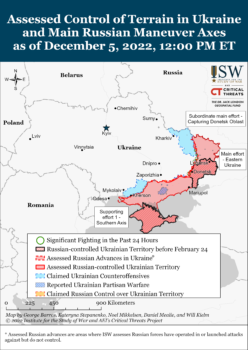Photo: BBC
Friday’s Coverage: Russia Fires 76 Missiles in Latest Barrage

Source: Institute for the Study of War
UPDATE 1617 GMT:
The latest Russian shelling of Kherson city has killed a 36-year-old man inside his car and injured a 70-year-old woman.
UPDATE 1525 GMT:
Electricity has been restored in Ukraine’s second-largest city Kharkiv, and the surrounding region.
UPDATE 1219 GMT:
Kyiv’s “glass bridge” has reopened after it was damaged by Russian missile and drone strikes on October 10.
The bridge connects the central Kyiv parks of Volodymyrska Hirka and Mariinsky.
Mayor Vitaly Klitschko said all 18 of the damaged glazed windows had been replaced, and railings and cables have been restored.
“One of our symbols of immortality is again happy to wait for Kyiv and guests of the capital,” Klitschko said.
UPDATE 1213 GMT:
Russia’s Foreign Ministry has lashed out at European Union sanctions adding almost 200 people to the blacklist and barring investment in the Russian mining industry.
On Thursday, EU leaders agreed to the ninth package of sanctions and provision of almost €18 billion ($19 billion) in financial aid to Ukraine.
Foreign Ministry spokeswoman Maria Zakharova said, “The current package will have the same effect as all the previous ones – exacerbation of socio-economic problems in the European Union itself.”
She did not explain why those problems would be exacerbated.
UPDATE 0811 GMT:
In January, Vladimir Putin’s top economic advisors warned him that an invasion of Ukraine would cripple Russia.
The advisors gave the assessment to Putin at his residence at Novo-Ogaryovo outside Moscow, briefing him about the likely consequences of international sanctions.
Summarizing a 39-page presentation, Herman Gref, the chief executive of State-owned Sberbank, said GDP could fall 30% in two years. Inflation would force a rise in interest rates to 35%, cutting real incomes by 20%. Russians would struggle not only to find high-tech products but also essentials such as food and medicines.
Putin cut Gref off and asked him what Russia should do to avoid the worst of the sanctions. The advisors were too cautious to warn the Russian leader off his invasion, which was launched on February 24.
One person at the January conference summarizes, “They were brave enough to ask the big man for a meeting. But they could not deliver the message. They were unable to deliver the only answer.”
Instead, they strove to mitigate the damage. Russia’s GDP decline is estimated to be 3.5% to 5.5% this year.
UPDATE 0751 GMT:
Planning his invasion of Ukraine, Vladimir Putin instructed the leader of Chechnya, Ramzan Kadyrov, to assassinate Ukraine President Voloydmyr Zelenskiy, say Ukrainian intelligence and security officials.
The officials says Putin tasked Kadyrov with the mission three weeks before the February 24 invasion when the Chechen visited the Kremlin. Alongside Russian special forces, Chechen units would enter Kyiv and find Zelenskiy.
The assassination attempt was foiled because of a leak from Russia’s State security agency FSB, said Oleksiy Danilov, the Secretary of Ukraine’s National Security and Defense Council.
Hours after the launch of the invasion, a Kadyrov subordinate reported to his boss, “The time is exactly 00:00. We start moving. More than 1,500 people, the best special forces, the best fighters.”
Putin’s plan ran into trouble when the Russian special forces could not complete the takeover of Hostomel Airport near Kyiv. The three Chechen columns of armored vehicles ran into stiff resistance on the outskirts of Ukraine. One column was destroyed. The other two tried to regroup but never entered the capital.
Kremlin spokesman Dmitry Peskov denied a Putin order to Kadyrov, saying an article in the Wall Street Journal is “totally absurd, baseless and false”.
Zelensky spoke at the start of the invasion about the Kremlin’s hopes for his assassination:
According to the information we have, the enemy has designated me as the number one target. My family is goal number two. They want to destroy Ukraine politically by destroying the head of state.
But the President refused to leave Kyiv for Lviv in western Ukraine, telling Western officials who contacted him, “I need ammunition, not a ride.”
UPDATE 0744 GMT:
Rescuers have retrieved the body of a 1 1/2 year-old boy from the rubble of a home in Kryvyi Rih in south-central Ukraine.
The recovery raises the city’s death toll to four from Friday’s Russian missile strikes. Another 13 civilians, including four children, have been injured.
ORIGINAL ENTRY: Ukrainians have withstood the ninth wave of Russian missile and drone strikes since October 10.
Russian forces fired 76 missiles — 72 Kalibr cruise missiles and 4 X-59 guided air missiles — from the Caspian and Black Sea and from land positions in Crimea on Friday morning. Ukraine’s air defenses downed 60 of them, including 37 of 40 fired on Kyiv.
Those that reached targets knocked out power in the capital Kyiv, the second-largest city Kharkiv, and several regions. Three civilians were killed and 13, including four children, were wounded when a residential building was leveled in Kryvyi Rih in south-central Ukraine.
Ukraine State energy company Ukrenergo initially declared a state of emergency, with capacity reduced by 50% through damage to thermal power plants, hydroelectric plants, and substations. The declaration was lifted after about six hours.
Kyiv Mayor Vitaly Klitschko said early Saturday morning that all residents have been reconnected to water supplies and the metro system is back in service. Heating has been restored to half the city and electricity returned to two-thirds, although “schedules of emergency outages are being implemented because the deficit of electricity is significant”.
Ukraine Foreign Minister Dmytro Kuleba urged the international community to respond with more military assistance for Kyiv:
For each Russian missile or drone aimed at Ukraine and Ukrainians there must be a howitzer delivered to Ukraine, a tank for Ukraine, an armored vehicle for Ukraine. This would effectively end Russian terror against Ukraine and restore peace and security in Europe and beyond.
— Dmytro Kuleba (@DmytroKuleba) December 16, 2022

